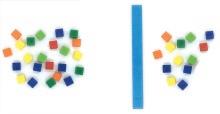
4 minute read
Topic: Grade 1 Module 5 Topic A
Topic A Grouping Units in Tens and Ones
Topic A builds on work with tens and ones that students completed in modules 3 and 4. At first students reason about units in the context of time. They learn through experience that smaller units can compose larger units. For example, they discover that 1 hour is made of 60 minutes and 1 half hour is made of 30 minutes.
Lessons build on the idea that smaller units can be used to compose larger units by considering the place value units of tens and ones. Students work with sets of objects to compose groups of 10 and represent two-digit totals in different ways. For example, 26 ones can also be represented as 1 ten 16 ones or 2 tens 6 ones. Working with numbers that have more than 9 ones prepares students for adding and subtracting with larger numbers in later grades. However, students come to understand that the digits we use to write a number, such as the 2 and the 6 in 26, show how many tens and ones there are when the number is expressed in its “most composed” form. This leads to recognition that the value of digits can be determined based on their place in the number. The value of the digit 2 can be expressed as 2 tens or 20. The value of the digit 6 can be expressed as 6 ones or simply 6. Students compose (or decompose) a total such as 26 by place value units: 20 and 6 or 2 tens 6 ones. Using different representations of the same total invites students to consider equivalence and deepens their number sense.
Several place value models that increase in complexity help students internalize the basic understanding that 10 ones are equivalent to 1 ten.
50 pennies 50 ones 5 dimes 5 tens
Groupable
Students group 10 ones to compose a new unit of ten. They may put 10 bears into 1 cup, link 10 cubes into a stick, or circle 10 donuts to represent a box of 10. Students can see and manipulate the individual units within the new larger unit. The size of the new unit is proportionally larger than the base unit.
Pregrouped
Students group 10 ones and trade them for a new item that represents 1 ten. For example, given 23 centimeter cubes, students trade 10 cubes for 1 ten-centimeter stick. The new item is proportionally larger than the base unit.
Nonproportional
Students trade 10 ones for a new item that represents 1 ten, but the ten looks different from the 10 ones. An example is trading 10 pennies for 1 dime. These models are nonproportional because the new unit, in this case a dime, is not visually 10 times larger than the base unit, or penny. Nonproportional models prepare students to work with place value disks in grades 2–5.
In this topic, students also add 10 and take 10 all at once from numbers. They add to and subtract from numbers in sequence: 54 + 10 = 64, 64 + 10 = 74, and so on. From this a pattern becomes visible: the digit in the tens place changes by 1, but the digit in the ones place remains the same.
Progression of Lessons
Lesson 1
Tell time to the hour and half hour by using digital and analog clocks.
4:30
The minute hand is pointing at the 6, and the hour hand is not at 5 yet, so it is 4:30.
Lesson 2
Count a collection and record the total in units of tens and ones.
1 ▸ M5 ▸ TA ▸ Lesson 2 EUREKA MATH2
bears
How many do you think there are? 50
10
10 10 10
10
5tens 2 ones
Total 52
2 LESSON
Copyright © Great Minds PBC
We composed tens by making groups EM2_0105TE_A_L02_classwork_1_studentwork_CE.indd 2 EM2_0105TE_A_L02_classwork_1_studentwork_CE.indd 2 07/04/21 3:45 PM of 10. We had 5 groups of ten and 2 extras. That is 52 bears.
Lesson 3
Recognize the place value of digits in a two-digit number.
053
05 3
After we composed all of the tens, there were 5 tens and 3 ones. The digits 5 and 3 make 53. The value of the digit 5 is 50 and the value of the digit 3 is 3.
Lesson 4
Represent a number in multiple ways by trading 10 ones for a ten.
I can trade 10 pennies for a dime and use dimes and pennies to show different ways to make 30 cents.
Lesson 5
Reason about equivalent representations of a number.
30 crayons 3 boxes of crayons
I would rather have 30 loose crayons so I can see all the colors, but both pictures have the same number of crayons. 30 ones is 30 and 3 tens is 30.
Lesson 6
Add 10 or take 10 from a two-digit number.
tens ones 6 16 26 36 46 56 66 76 86
tens ones 96 86 76 66 56 46 36 26 16
When I add ten, the digit in the tens place is 1 more. When I subtract ten, the digit in the tens place is 1 less.

